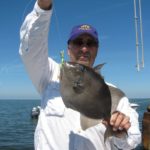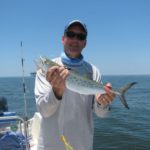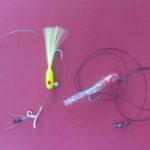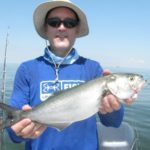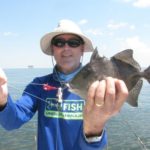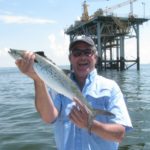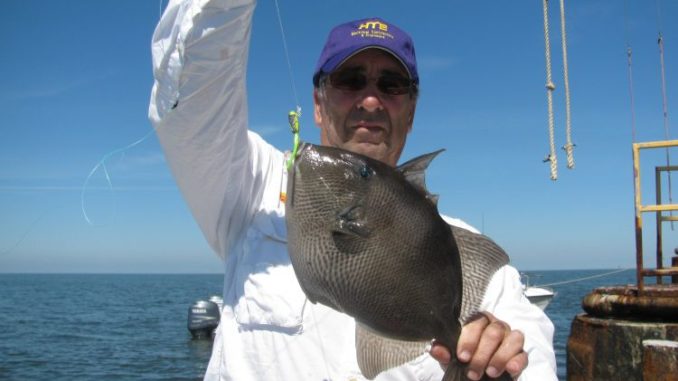
When the slack tide has the inshore bite shut down, head to the nearshore rigs out of Grand Isle to find plenty of action from the swarms of triggerfish, Spanish mackerel and even bluefish.
“But nobody actually fishes for TAAAW-PON during the Grand Isle TAAAW-PON Rodeo!” Artie roared.
“Yeah!” Doc laughed, as a baffled Anthony (Trisha’s Floridian brother-in-law) frowned and looked around. “So who’s the wise guy who named a fishing tournament in a place famous for its seafood eatery after a fish NOBODY EATS!”
“And hardly any natives even FISH FOR!” Pelayo added, as Anthony kept looking around in utter bafflement at the response to what probably struck him as a perfectly reasonable question.
Poor Anthony.
Here he was, an avid Florida fisherman visiting Trisha and Doc at their Grand-Isle Chateau from his lifelong home in Ft. Myers for the Tarpon Rodeo.
And for some insane reason he assumed he’d be fishing for the rodeo’s namesake.
“Let’s cut Ant-knee some slack!” Artie laughed from the keg as his cup ran over with foam. “Poor boy needs some local learnin!”
Ah, yes: Never fails, does it? Tap that second keg. Pop that fifth wine cork — especially on a gorgeously starlit and amazingly un-muggy night while lounging amongst lifelong friends on the porch of Doc’s Grand Isle Chateau and listening to the gentle lapping of the waves, while watching the flickering lights of offshore platforms dotting the dark gulf, while listening to the Stones’ “You Can’t Always Get What you Want” — and VOILA!
Suddenly everybody’s a philosopher.
In this setting, the ironies of everyday life always come sharply into focus.
“OK, Aristotle,” Trisha said as she slammed the screen door, burst upon the scene and shattered the mood. “Y’all finally figure out tomorrow’s menu? Those few teenzy-tiny specks y’all managed to keep from among the hundred or so 10- to 11-inchers we caught and threw back this afternoon ain’t gonna cut it! Not to feed 23 people tomorrow night — ya follow me?”
“Hey ANT-KNEE!” Artie called. “Why don’t you inform your sista-in-law about tomorrow’s fishing plans?”
Pelayo had just clued him in — which pumped him back up after his Tarpon letdown.
You see, we planned a relatively short haul to the GI 40s for triggerfish, with Spanish mackerel and maybe some bluefish taking up the slack after we limited out on trigs
All of these fish are HIGHLY prized in Florida.
You read right: I wrote “limited out.”
Astoundingly enough, nowadays the limit on grey triggerfish is two per person — and the season is completely closed during the entire month of June.
The size limit is 14 inches FORK length.
Apparently, trigs hover as perilously close to extinction as red snapper — at least according to the feds.
Apparently, those HUGE schools of pink and grey things that grudgingly part to make way for Louisiana’s rig divers must be unicorns instead of fish.
The point is that, despite the microscopic red snapper season, there’s still plenty of ways for small-boaters to fill a box with delectable Gulf fish during an action-packed trip to our shallower rigs.
The next morning, we roared out through Caminada Pass, already high-fiving.
The weatherman — believe it or not — had been RIGHT! One- to 3-foot seas!
We skimmed easily over the gentle swells with Ant-Knee perched proudly on the bow, wind in his face, taking in the scenery and smiling from ear to ear.
In short order, we tied up to a rig in the GI 43 bloc, and — hallelujah! — the gentle breeze carried us right under the shade.
Perfect.
The depth finder showed 70-foot depths. In our experience, legal-sized triggerfish start showing up at about the same depths as red snapper do — around 50 foot depths.
And the very conditions that would make inside fishing tough made them ideal offshore. A slack tide inside means a slack current out here, hence our baited jigs would stay close to the beams, where trigs (and mangroves and pompano) tend to hang out.
Scuba diving under the rigs has also taught us that most of the fish around a platform tend to concentrate on the upcurrent side of the rig.
A study by the Coastal Fisheries Institute a few years ago confirmed our observations. CFI scientists dropped a device under rigs that took sonar pictures, and they monitored the pictures for 20 months.
Most of the blips occurred on the upcurrent side. But a slack current makes this less of an issue.
For this type of fishing, we’ve found you simply can’t beat the classic shad rig — and we mean the classic one (called “speck rigs” nowadays.)
You know: The one with the small hooks. Indeed, it’s those small hooks that make the difference because triggerfish (and pompano, which often hang out beneath the same rigs) have small mouths.
These small hooks mean we haul aboard many fish that would otherwise simply steal the bait.
Trigs, Spanish and blues also have sharp, vicious teeth that quickly shred any rubber or plastic you care to attach to your jighead out here. And those old-style shad rigs are all lead. So they hold up well to the brutal punishment from these ferocious, sharp-toothed fish.
Double-eyed jig heads with a small silver or white metalflake rubber tail also work well, if lasting less long (those teeth again.) But again, get the smallest hooks possible on the smallest (1/8-ounce) jigheads.
The jigs forthrightly named “pompano jigs” also work well, again owing to their relatively small hooks but also to their heavy heads that help get them down and close to the beams during strong currents.
Needless to add, but we tip all of the above with shrimp or squid — or when targeting trigs, a little chunk of cut hardtail with skin on for extra-toughness and to better foil the notorious bait stealing of triggerfish.
Ahead of these baits we like 3 feet of 20- to 30-pound-test nylon-coated stainless steel wire leaders in brown or black. We tie them directly (easy with this type of leader material) to the jig on one end and tie — this is important! — a black swivel on the other end.
You see, when you’ve got a fish on out here, the swarms of Spanish macks and blues often follow it around and attack those silver or gold swivels flashing around enticingly.
WHAM!
And, given those teeth, your line goes instantly limp.
It took us a while (and many jigs) to finally finger the culprit for most “popped” lines. It’s usually NOT the fish you initially hooked; it’s one of his buddies chasing him around and snapping at the line.
We found that the black swivels and nylon-coated wire leaders worked like a charm against this exasperating phenomenon.
Interestingly, we also found that tandem rigging the shad or double-eyed jigs further guards against cut lines. The second fish — instead of grabbing at the swivel — tends to grab the second jig.
WHAM!
But instead of a cut line, now you’ve got a literal “double whammy” of hooked Spanish, blue or pompano.
And talk about a BATTLE! Hence our preference for 15- to 20-pound line on our medium spinning reels.
“What’s THAT?” Anthony asked, pointing toward some splashes on the calm surface just as Pelayo clanged the rig hook.
“Spanish!” Artie laughed. “I can see ’em jumpin’ straight out da waaaw-dah! Cast at ’em!”
In seconds Ant-Knee was whooping from the bow, his rod high overhead and his reel screeching crazily!
“WHOOO-HOOO!” he hollered. “Who needs tarpon when we got these?”
From the bend in his rod, Anthony seemed to have hooked into a double-whammy.
Sure enough.
“Lemme get the net for those!” I howled, while rushing over after spotting the size of his two macks.
By the time Anthony’s macks were thrashing around and bloodying-up the box, Pelayo had already boated two trigs — his limit!
“A no-brainer!” he explained. “Look!”
Pelayo pointed to the dark greenish water.
“You can see the doggone trigs right there!” he said.
Indeed, some delectable white-fleshed trigs were hanging barely 10 feet from the surface around the rig’s beams, alongside the sheepshead and spadefish.
“Probably plenty, PLENTY more below those!” Pelayo roared. “Get ya a little chunk of that hardtail I diced up, sweeten your shad rig — and get your bait down there!”
As proof of Pelayo’s prediction, I soon felt the nibbles.
Yes, triggerfish are nibblers more than strikers. Nothing like the WHAM! of a Spanish.
The nibbles turned into a steady pressure, so I struck — and in seconds my rod bent over and smashed the railing as I slugged it out with chunky trig.
The trigs hugged the rig’s beams, and the ravenous Spanish and blues were in a constant feeding frenzy on the outside.
“Another trig for da grill?” Artie asked, as he laughed and rebaited his tandem jigs and pointed his pole toward the barnacle-encrusted beam.
“Or another mack or blue for the fryer and broiler?” he added while swiveling and pointing away from the rig.
It was THAT easy. Catching fish after fish was a simple matter of deciding which direction you felt like casting.
As predicted, while fishing a grand total of two rigs, trig limits came quickly, followed by the ferocious, spool-sizzling Spanish macks and a few blues.
The action kept us in a non-stop fishing frenzy as the box filled with double whammys.
“This is AMAZING!” Anthony laughed. “Man, I’ve been fishing all my life around Florida — and I ain’t NEVER fished a place where EVERY cast gets you either a strike or a FISH!”
